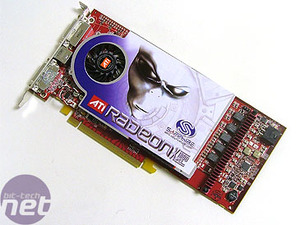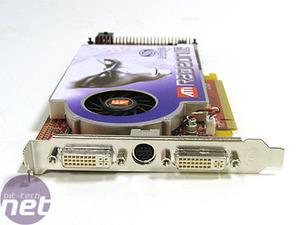
Today, we are going to be looking at Sapphire's implementation of the Radeon X1800XL. It is not surprising to see Sapphire as one of the first board partners to ship ATI's new video cards, as they're ATI's biggest partner worldwide by a considerable margin. Sapphire's X1800XL is clocked at the same 500/1000MHz clock speeds as ATI's reference design, and the cooler looks very similar to the photographs we've seen of the reference card.
The architecture, in conventional terms, has sixteen pixel pipelines, eight vertex shaders, and is able to output sixteen pixels per clock. However, the architecture has some big changes that make it very different from ATI's previous R420/R480 architecture. Over the course of this article, we'll explain the architecture behind ATI's new X1000 series to you, and then go on to evaluate the gaming performance of Sapphire's Radeon X1800XL.




The cooler is a single slot cooler with an adjustable speed centrifugal fan. In its current state, the fan operates at its higher speed setting more often than its at the lower speed, meaning that the card is often loud. When gaming, the card operates at full speed all of the time and it was clearly louder than the cooler on both the GeForce 7800 GT and GTX. During 2D mode, there are several occasions when the fan changed from the lower speed up to the higher speed setting. One rather bizarre incident of adjustable fan craziness was when our monitor went in to stand by mode - seconds later the fan would switch to its full operating speed creating unnecessary and unacceptable noise. Without doubt, we feel that the adjustable fan speed thresholds need a little reworking in the VGA BIOS, as we found this card is unexpectedly loud for an ATI video card.
The card runs hot to the touch, but not hot enough to require a dual slot cooler. At the least, we hope that Sapphire and the rest of ATI's partners will spend time improving the cooling solution on this card, or at least the fan speed thresholds. Don't get me wrong, it's great that this card has a single slot cooling solution, but in practice, the cooler seems to be lacking in the silence department. As we've said though, we hope it is just a case of tweaking the temperature thresholds in the VGA BIOS.


The bundle includes Sapphire Select, allowing you to choose your bundle from a selection of titles. We were introduced to this idea at CeBit and it is great to see that Sapphire have gone ahead to include it with their Radeon X1800XL. In simple terms, there is a selection of games included on a DVD, which all have a 60-minute trial.
Once you've used the trial period up, you'll be asked to enter a registration code or asked if you would like to purchase the game to continue playing. The days of getting the same titles over and over again when you upgrade your video card are gone - if the games bundle is important to you, Sapphire seems to have it all covered. Finally, there is some additional software included to get you started with the VIVO capabilities that this card has. Sapphire has included PowerDVD and PowerDirector from Cyberlink, along with an instruction manual and driver installation CD.

MSI MPG Velox 100R Chassis Review
October 14 2021 | 15:04







Want to comment? Please log in.